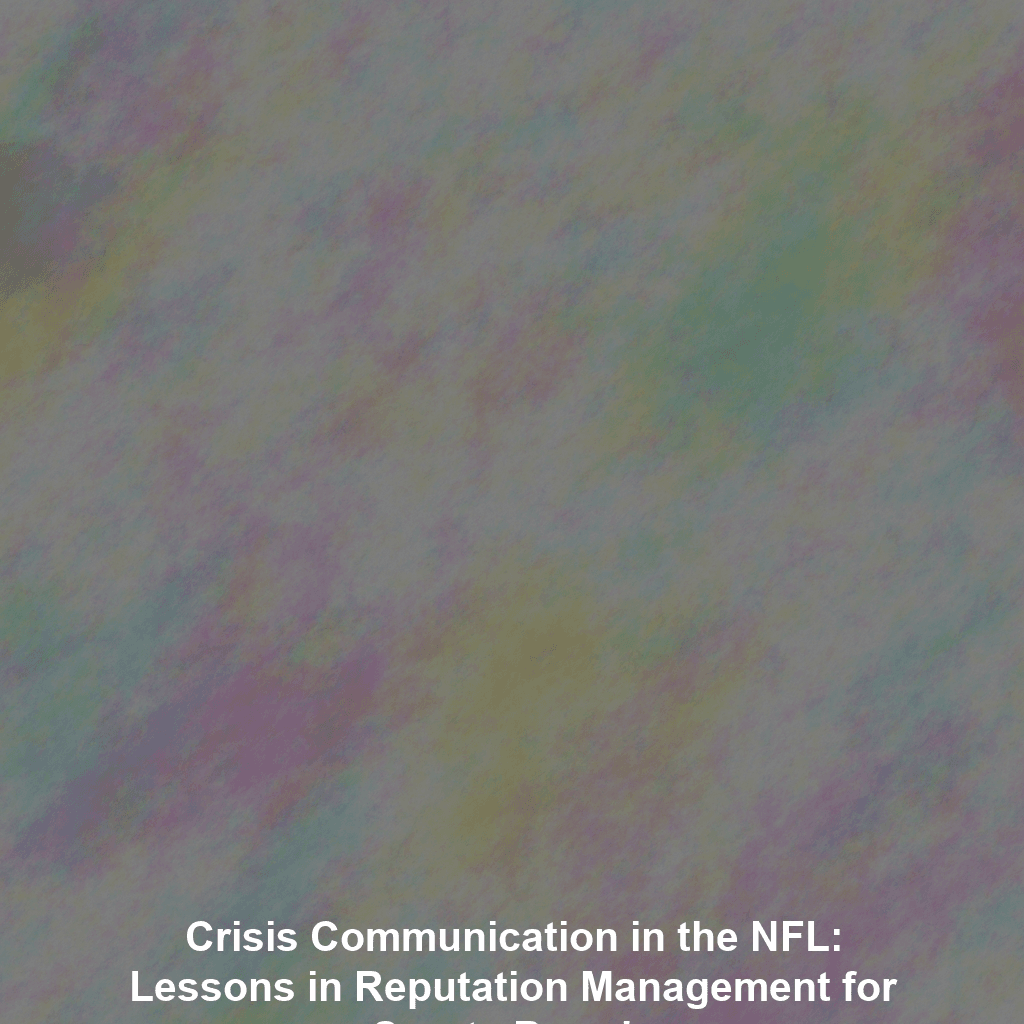The National Football League (NFL), a multi-billion dollar behemoth, thrives on the passion of its fans and the dedication of its players. But with such a high profile comes intense scrutiny. From player misconduct to stadium funding controversies, NFL teams are constantly navigating potential reputational minefields. How they handle these crises can make or break their brand image, impacting everything from ticket sales to sponsorship deals. This article delves into the critical world of crisis communication within the NFL, analyzing past case studies and providing actionable advice for sports brands to effectively manage reputational risks.
Understanding the High Stakes: Reputation in Professional Sports
Reputation is paramount in the sports industry. It influences fan loyalty, sponsorship opportunities, and the overall financial health of an organization. A strong, positive reputation attracts fans, boosts merchandise sales, and secures lucrative partnerships. Conversely, a tarnished reputation can lead to boycotts, lost revenue, and a damaged brand that takes years to rebuild.
The Unique Challenges Facing NFL Teams
NFL teams face unique challenges when it comes to crisis communication:
- Intense Media Scrutiny: Every action, both on and off the field, is subject to intense media coverage and public debate.
- Passionate Fan Base: Fans are emotionally invested in their teams, making them highly sensitive to scandals and controversies.
- Social Media Amplification: Social media platforms amplify both positive and negative news, making it crucial to respond quickly and effectively.
- Player Behavior: The actions of individual players can significantly impact the team’s reputation.
- Financial Stakes: The league and individual teams are hugely profitable. Any major PR disaster can result in millions of dollars in lost revenue and legal fees.
Case Studies: Crisis Communication Wins and Losses in the NFL
Analyzing past crises provides valuable insights into effective and ineffective communication strategies. Here are some notable examples:
Case Study 1: The Ray Rice Scandal (Baltimore Ravens) – A Failure in Transparency
In 2014, the Ray Rice domestic violence scandal shook the NFL. The Baltimore Ravens initially downplayed the incident, a move that backfired spectacularly when video evidence surfaced, revealing the severity of the abuse. The Ravens’ initial statement lacking strong condemnation of Rice’s actions led to widespread outrage. While they eventually released Rice and issued a stronger statement, the initial missteps severely damaged their reputation. This case highlights the critical importance of transparency and taking immediate, decisive action when dealing with serious allegations.
Lessons Learned:
- Transparency is key: Attempting to hide or downplay the truth only exacerbates the situation.
- Act swiftly and decisively: Delaying action can be interpreted as condoning the behavior.
- Show genuine remorse: Acknowledge the severity of the situation and express empathy for the victims.
Case Study 2: Deflategate (New England Patriots) – A Masterclass in Defense (and Some Controversy)
The “Deflategate” scandal, involving allegations that the New England Patriots intentionally deflated footballs, offers a contrasting example. While the scandal itself was controversial, the Patriots employed a multifaceted defense strategy. They vehemently denied the allegations, presented scientific evidence to support their claims, and launched a counter-narrative that portrayed the NFL as being overly aggressive in their investigation. Although many still believe the Patriots were guilty, their proactive defense strategy helped mitigate the reputational damage and maintain fan loyalty. However, some argue their approach lacked full transparency and accountability.
Lessons Learned:
- Proactive communication is crucial: Don’t wait for the media to control the narrative.
- Present a strong defense (if appropriate): Back up your claims with evidence and data.
- Control the narrative: Frame the situation in a way that is favorable to your brand.
- Be prepared for prolonged battles: Deflategate lasted years, requiring sustained communication efforts.
Case Study 3: The Washington Commanders’ Workplace Culture – Accountability and Change
The Washington Commanders (formerly the Washington Redskins) faced a major crisis regarding their workplace culture, characterized by allegations of sexual harassment and a toxic environment. The organization commissioned an independent investigation and publicly released its findings. While the initial response was criticized, they eventually implemented significant changes, including firing key personnel and establishing new policies to promote a safer and more inclusive workplace. This case highlights the importance of taking accountability and demonstrating a commitment to positive change, even if it means making difficult decisions.
Lessons Learned:
- Take accountability: Acknowledge the problems and take responsibility for your actions.
- Implement meaningful changes: Don’t just pay lip service to reform. Take concrete steps to address the underlying issues.
- Communicate progress transparently: Keep stakeholders informed about the steps you are taking to improve the situation.
Case Study 4: Stadium Funding Controversies (Various Teams) – Engaging the Community
Many NFL teams face public scrutiny when seeking public funding for new stadiums. These situations can quickly turn into PR nightmares if not handled carefully. Successful teams proactively engage with the community, highlighting the economic benefits of a new stadium (job creation, increased tourism) and addressing concerns about the financial burden on taxpayers. They may also partner with local organizations to demonstrate their commitment to the community’s well-being. Failure to do so can result in significant public opposition and delays or even rejection of funding proposals.
Lessons Learned:
- Engage the community early and often: Don’t wait until the last minute to seek public support.
- Highlight the benefits for the community: Focus on how the project will improve the lives of local residents.
- Address concerns transparently: Acknowledge and address legitimate concerns about the project’s impact.
- Partner with local organizations: Build relationships with community leaders and stakeholders.
Key Strategies for Effective Crisis Communication in the NFL
Based on these case studies and best practices in public relations, here are some key strategies for NFL teams (and any sports brand) to effectively manage crises:
1. Develop a Comprehensive Crisis Communication Plan
A well-defined crisis communication plan is essential. This plan should outline procedures for identifying, assessing, and responding to potential crises. It should include:
- Identification of potential crises: Brainstorm a list of potential scenarios that could damage the team’s reputation (e.g., player misconduct, stadium issues, financial scandals).
- Designation of a crisis communication team: Identify key personnel who will be responsible for managing the crisis (e.g., CEO, PR director, legal counsel).
- Development of key messages: Prepare draft statements and talking points for various scenarios.
- Establishment of communication channels: Identify the best channels for communicating with different stakeholders (e.g., media, fans, sponsors).
- Regular training and simulations: Conduct regular training exercises to ensure that the crisis communication team is prepared to respond effectively.
2. Prioritize Transparency and Honesty
In today’s hyper-connected world, attempts to hide or downplay the truth are likely to backfire. Transparency and honesty are crucial for maintaining credibility and building trust. This means:
- Acknowledge the situation promptly: Don’t wait for the media to break the story.
- Provide accurate and timely information: Avoid speculation and stick to the facts.
- Admit mistakes: If the team or its players have made a mistake, acknowledge it and apologize.
- Be open to scrutiny: Cooperate with investigations and answer questions honestly.
3. Take Decisive Action
Hesitation can be detrimental during a crisis. Taking decisive action demonstrates leadership and a commitment to resolving the situation. This may involve:
- Suspending or releasing players: If a player has engaged in misconduct, take appropriate disciplinary action.
- Firing employees: If employees are found to have engaged in wrongdoing, terminate their employment.
- Implementing new policies: Develop and implement new policies to prevent similar situations from happening in the future.
- Issuing public apologies: Apologize to those who have been affected by the crisis.
4. Emphasize Empathy and Compassion
In times of crisis, it’s important to show empathy and compassion for those who have been affected. This means:
- Acknowledging the pain and suffering of victims: Express sympathy for those who have been harmed by the crisis.
- Offering support and assistance: Provide resources to help victims cope with the situation.
- Demonstrating a commitment to healing: Show that you are committed to helping the community recover from the crisis.
5. Monitor Social Media and Engage in Dialogue
Social media platforms are a key battleground during a crisis. It’s essential to monitor social media channels, engage in dialogue with fans, and address concerns and misinformation. This means:
- Tracking mentions of the team and the crisis: Use social media monitoring tools to track what people are saying online.
- Responding to comments and questions: Engage with fans and address their concerns and questions.
- Correcting misinformation: Correct any false or misleading information that is being spread online.
- Sharing updates and information: Use social media to share updates and information about the crisis and the team’s response.
6. Control the Narrative: Proactive Messaging
Don’t let the media control the narrative. Proactively communicate your message to shape public perception. This can involve:
- Holding press conferences: Provide updates and answer questions from the media.
- Releasing statements: Issue statements to clarify your position and address concerns.
- Using social media: Share your message directly with fans.
- Working with influencers: Partner with trusted influencers to spread your message.
7. Learn from the Crisis and Improve
Every crisis presents an opportunity for learning and improvement. After the crisis has passed, conduct a thorough review of your crisis communication plan and processes. Identify what worked well and what could be improved. Use these lessons to strengthen your crisis preparedness and prevent future crises.
Actionable Advice for Sports Brands: Preparing for the Inevitable
Reputational crises are almost inevitable in the high-stakes world of professional sports. By taking proactive steps to prepare, sports brands can mitigate the damage and emerge stronger. Here’s some actionable advice:
- Invest in a Robust Crisis Communication Plan: Don’t wait for a crisis to hit. Develop a detailed plan now.
- Train Your Team: Conduct regular training exercises to ensure your team is prepared to execute the plan.
- Build Strong Relationships with the Media: Cultivate relationships with journalists before a crisis occurs.
- Monitor Your Online Reputation: Use social media monitoring tools to track sentiment and identify potential threats.
- Establish a Clear Social Media Policy: Set guidelines for players and employees regarding social media conduct.
- Prioritize Ethical Conduct: Foster a culture of ethics and integrity throughout the organization.
- Be Prepared to Act Decisively: Have a clear decision-making process in place so you can act quickly and effectively when a crisis occurs.
- Consult with Experts: Don’t hesitate to seek advice from public relations professionals and legal counsel.
- Practice Active Listening: Pay attention to fan feedback and address concerns promptly.
- Focus on Long-Term Reputation: Remember that your actions during a crisis will have a lasting impact on your brand.
Conclusion: Protecting the Brand in a Crisis-Prone World
The NFL, with its intense media scrutiny and passionate fan base, serves as a crucible for crisis communication. The case studies analyzed here demonstrate that transparency, accountability, proactive messaging, and genuine empathy are essential ingredients for navigating reputational storms. By learning from past mistakes and implementing the strategies outlined in this article, NFL teams and other sports brands can better protect their brand image, maintain fan loyalty, and emerge from crises stronger and more resilient. The key is to view crisis communication not as a reactive measure, but as an integral part of a proactive, long-term reputation management strategy.
 Skip to content
Skip to content

